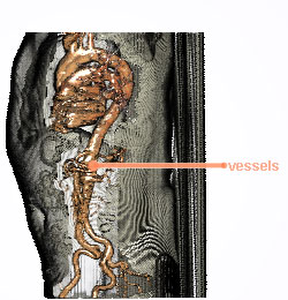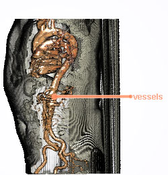Information
- Publication Type: Miscellaneous Publication
- Workgroup(s)/Project(s):
- Date: 2006
Abstract
This tutorial presents recent research and developments from academia in illustrative visualization focusing on its use for medical/science subjects. Lectures are organized within a comprehensive illustration framework, focusing on three main components:• Traditional and computerized illustration techniques and principles for technical and scientific subjects
• Evaluation and practical use
• Viewing & rendering
Presentation of topics is balanced between descriptions of traditional methods and practices, practical implementation motivated approaches and evaluation, and detailed descriptions and analysis of illustrative techniques and algorithms. We begin in the morning with a lecture presenting an overview of traditional illustration for technical, scientific, and medical subjects. This is followed by a description of the main components in an illustrative visualization pipeline for developing systems to assist technical and scientific illustrators. The tutorial progresses with an overview of the techniques used in illustration as well as approaches to evaluate their use and effectiveness. The morning concludes with the start of the “viewing and rendering” section. The three lectures in this section describe the latest approaches in computerized illustration algorithms for scientific and medical data for both surface and volumetric data, covering techniques from silhouette enhancement to stippling, to cut-away viewing, labeling, and focus+context rendering. Each of the lectures also discusses practical issues in making these techniques interactive and their use for different application domains. The tutorial includes a trained medical illustrator discussing the principles/caveats/issues in using illustration techniques in real-world medical applications. This lecture will also describe an evaluation, from an illustrator’s point of view, of the use and quality of the techniques presented throughout the day. The tutorial concludes with discussion on specific medical case studies where illustrative visualization has been effectively applied.
IEEE Visualization 2006 Tutorial Page: http://vis.computer.org/vis2006/session/tutorials.html#t3
See also previous tutorials on Illustrative Visualization:
Eurographics 2006 Tutorial on Illustrative Visualization for Science and Medicine http://www.cg.tuwien.ac.at/research/publications/2006/tut-eg-2006/
SIGGRAPH 2006 Course on Illustrative Visualization for Science and Medicine http://www.cg.tuwien.ac.at/research/publications/2006/tut-siggraph-2006/
IEEE Visualization 2005 Tutorial on Illustrative Visualization http://www.cg.tuwien.ac.at/research/publications/2005/Viola-vistutillustrativevis/
Eurographics 2005 Tutorial on Illustrative Visualization http://www.cg.tuwien.ac.at/research/publications/2005/eg-tut2005-iv/
Additional Files and Images
Weblinks
No further information available.BibTeX
@misc{tut-vis-2006,
title = "IEEE Visualization Tutorial on Illustrative Visualization
for Science and Medicine",
author = "Ivan Viola and Mario Costa Sousa and David Ebert and Bill
Andrews and Bruce Gooch and Stefan Bruckner and Bernhard
Preim and Don Stredney and Nikolai Svakhine and Christian
Tietjen",
year = "2006",
abstract = "This tutorial presents recent research and developments from
academia in illustrative visualization focusing on its use
for medical/science subjects. Lectures are organized within
a comprehensive illustration framework, focusing on three
main components: • Traditional and computerized
illustration techniques and principles for technical and
scientific subjects • Evaluation and practical use •
Viewing & rendering Presentation of topics is balanced
between descriptions of traditional methods and practices,
practical implementation motivated approaches and
evaluation, and detailed descriptions and analysis of
illustrative techniques and algorithms. We begin in the
morning with a lecture presenting an overview of traditional
illustration for technical, scientific, and medical
subjects. This is followed by a description of the main
components in an illustrative visualization pipeline for
developing systems to assist technical and scientific
illustrators. The tutorial progresses with an overview of
the techniques used in illustration as well as approaches to
evaluate their use and effectiveness. The morning concludes
with the start of the “viewing and rendering” section.
The three lectures in this section describe the latest
approaches in computerized illustration algorithms for
scientific and medical data for both surface and volumetric
data, covering techniques from silhouette enhancement to
stippling, to cut-away viewing, labeling, and focus+context
rendering. Each of the lectures also discusses practical
issues in making these techniques interactive and their use
for different application domains. The tutorial includes a
trained medical illustrator discussing the
principles/caveats/issues in using illustration techniques
in real-world medical applications. This lecture will also
describe an evaluation, from an illustrator’s point of
view, of the use and quality of the techniques presented
throughout the day. The tutorial concludes with discussion
on specific medical case studies where illustrative
visualization has been effectively applied. IEEE
Visualization 2006 Tutorial Page:
http://vis.computer.org/vis2006/session/tutorials.html#t3
See also previous tutorials on Illustrative Visualization:
Eurographics 2006 Tutorial on Illustrative Visualization for
Science and Medicine
http://www.cg.tuwien.ac.at/research/publications/2006/tut-eg-2006/
SIGGRAPH 2006 Course on Illustrative Visualization for
Science and Medicine
http://www.cg.tuwien.ac.at/research/publications/2006/tut-siggraph-2006/
IEEE Visualization 2005 Tutorial on Illustrative
Visualization
http://www.cg.tuwien.ac.at/research/publications/2005/Viola-vistutillustrativevis/
Eurographics 2005 Tutorial on Illustrative Visualization
http://www.cg.tuwien.ac.at/research/publications/2005/eg-tut2005-iv/
",
URL = "https://www.cg.tuwien.ac.at/research/publications/2006/tut-vis-2006/",
}


